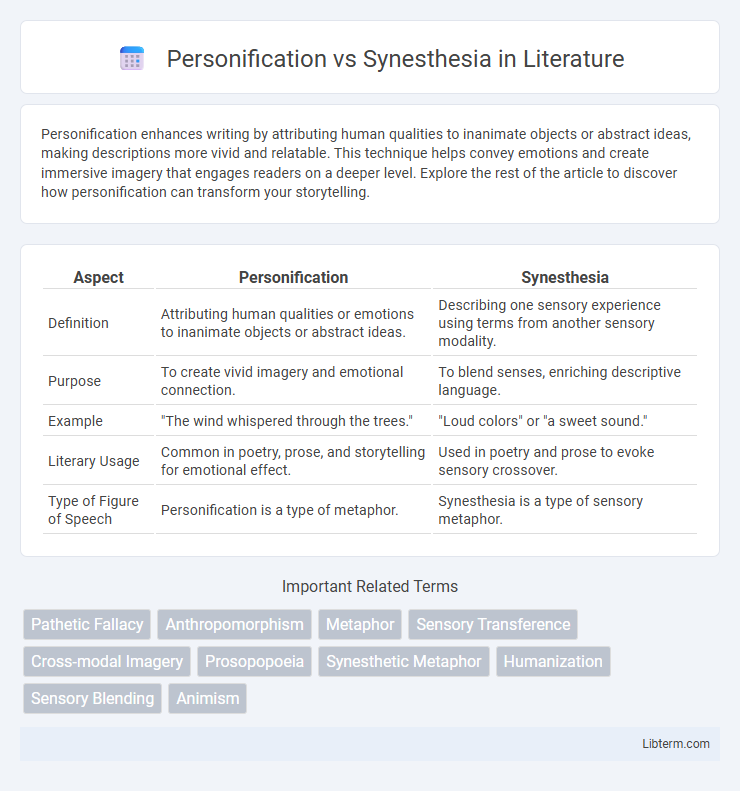Personification enhances writing by attributing human qualities to inanimate objects or abstract ideas, making descriptions more vivid and relatable. This technique helps convey emotions and create immersive imagery that engages readers on a deeper level. Explore the rest of the article to discover how personification can transform your storytelling.
Table of Comparison
| Aspect | Personification | Synesthesia |
|---|---|---|
| Definition | Attributing human qualities or emotions to inanimate objects or abstract ideas. | Describing one sensory experience using terms from another sensory modality. |
| Purpose | To create vivid imagery and emotional connection. | To blend senses, enriching descriptive language. |
| Example | "The wind whispered through the trees." | "Loud colors" or "a sweet sound." |
| Literary Usage | Common in poetry, prose, and storytelling for emotional effect. | Used in poetry and prose to evoke sensory crossover. |
| Type of Figure of Speech | Personification is a type of metaphor. | Synesthesia is a type of sensory metaphor. |
Defining Personification and Synesthesia
Personification attributes human characteristics to non-human objects or abstract concepts, enhancing emotional connection and vivid imagery in literature. Synesthesia involves the blending of sensory experiences, such as associating colors with sounds or tastes with shapes, creating a unique cross-sensory perception. Both figures of speech enrich descriptive language but operate through different cognitive and experiential mechanisms.
Origins and Historical Context
Personification, rooted in ancient Greek literature, emerged as a rhetorical device to attribute human qualities to non-human entities, enhancing emotional engagement in storytelling and poetry. Synesthesia, with origins traced back to early neurological studies in the 19th century, describes a sensory phenomenon where stimulation of one sense involuntarily triggers another, influencing both artistic expression and scientific understanding. The historical context of personification is steeped in mythological and literary traditions, while synesthesia's development is closely linked to advances in psychology and neurology.
Key Differences Between Personification and Synesthesia
Personification attributes human qualities to non-human entities, creating vivid imagery by giving objects or ideas lifelike traits. Synesthesia, on the other hand, is a neurological condition or literary technique where one sensory experience involuntarily triggers another, like associating colors with sounds. Unlike personification's metaphorical humanization, synesthesia involves cross-sensory perception blending or descriptive fusion to enhance sensory experiences.
Common Uses in Literature
Personification frequently appears in poetry and prose to attribute human qualities to animals, objects, or abstract ideas, enhancing emotional connection and vivid imagery. Synesthesia is commonly employed in literary works to blend sensory experiences, allowing authors to evoke complex perceptions by describing one sense through another, such as "a loud color" or "tasting a sound." Both devices serve to deepen readers' engagement by enriching sensory details and creating imaginative, immersive narratives.
Examples of Personification in Writing
Personification attributes human qualities to non-human objects, such as "the wind whispered through the trees" or "the sun smiled down on us," enhancing imagery in writing. In contrast, synesthesia blends sensory experiences, like describing a color as "loud" or a sound as "bright." Examples of personification include phrases like "the angry storm pounded the roof" and "time flies," which create vivid emotional connections by giving life to inanimate elements.
Examples of Synesthesia in Writing
Synesthesia in writing often involves describing one sense through terms related to another, such as "a loud color" or "a sweet sound," creating vivid sensory experiences. Unlike personification, where non-human entities are given human traits, synesthesia blends sensory perceptions to evoke emotional responses, as seen in phrases like "bitter cold" or "sharp taste of silence." Classic examples include Baudelaire's "Correspondences" and Nabokov's detailed accounts of grapheme-color synesthesia in his prose.
Impact on Reader Perception
Personification assigns human traits to non-human entities, evoking empathy and making abstract concepts relatable, thereby enhancing emotional connection and comprehension. Synesthesia blends sensory experiences, such as associating colors with sounds, creating vivid imagery that heightens sensory engagement and deepens the reader's imaginative involvement. Both techniques manipulate perception, but personification appeals to emotional understanding while synesthesia enriches sensory detail, significantly influencing how readers interpret and feel the text.
Role in Poetry and Prose
Personification attributes human characteristics to non-human entities, enriching poetry and prose by creating relatable imagery and emotional depth that engages readers' empathy. Synesthesia blends sensory experiences, such as describing colors with sounds or tastes, enhancing vividness and originality in literary works through multi-sensory appeal. Both devices deepen sensory engagement but personification emphasizes emotional connection, while synesthesia intensifies perceptual complexity.
Visual and Sensory Language Techniques
Personification attributes human characteristics to non-human entities, enhancing visual imagery by making descriptions more relatable and vivid, such as "the wind whispered through the trees." Synesthesia blends sensory experiences, often merging visual with auditory or tactile sensations, like "a loud color" or "a sharp taste," to create a multi-sensory impact. Both techniques enrich sensory language but differ in approach: personification anthropomorphizes, while synesthesia fuses senses for deeper experiential engagement.
Choosing Between Personification and Synesthesia
Choosing between personification and synesthesia depends on the desired sensory or emotional impact in writing. Personification attributes human characteristics to inanimate objects, enhancing emotional connection and relatability, while synesthesia merges multiple sensory experiences, creating vivid and immersive imagery. Writers should consider the context and effect, opting for personification to evoke empathy and synesthesia to intensify sensory perception.
Personification Infographic

 libterm.com
libterm.com